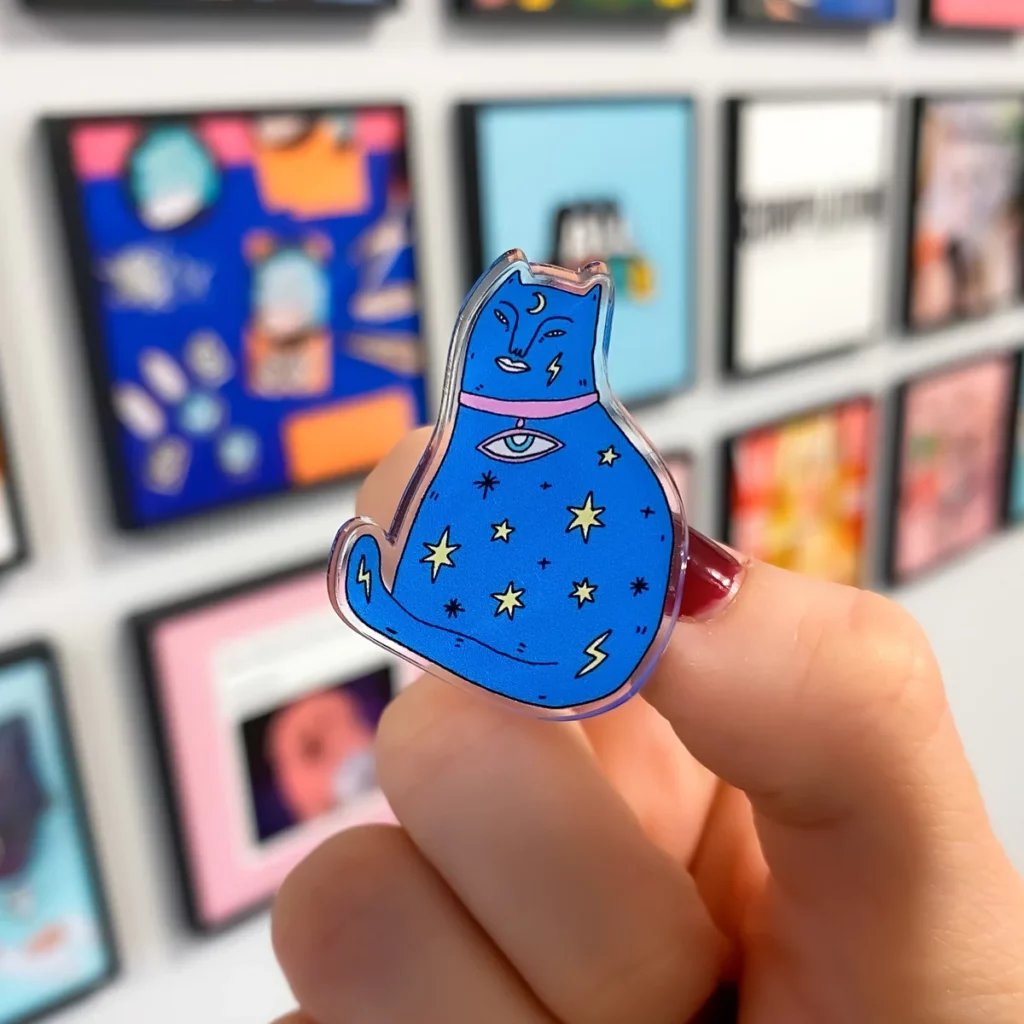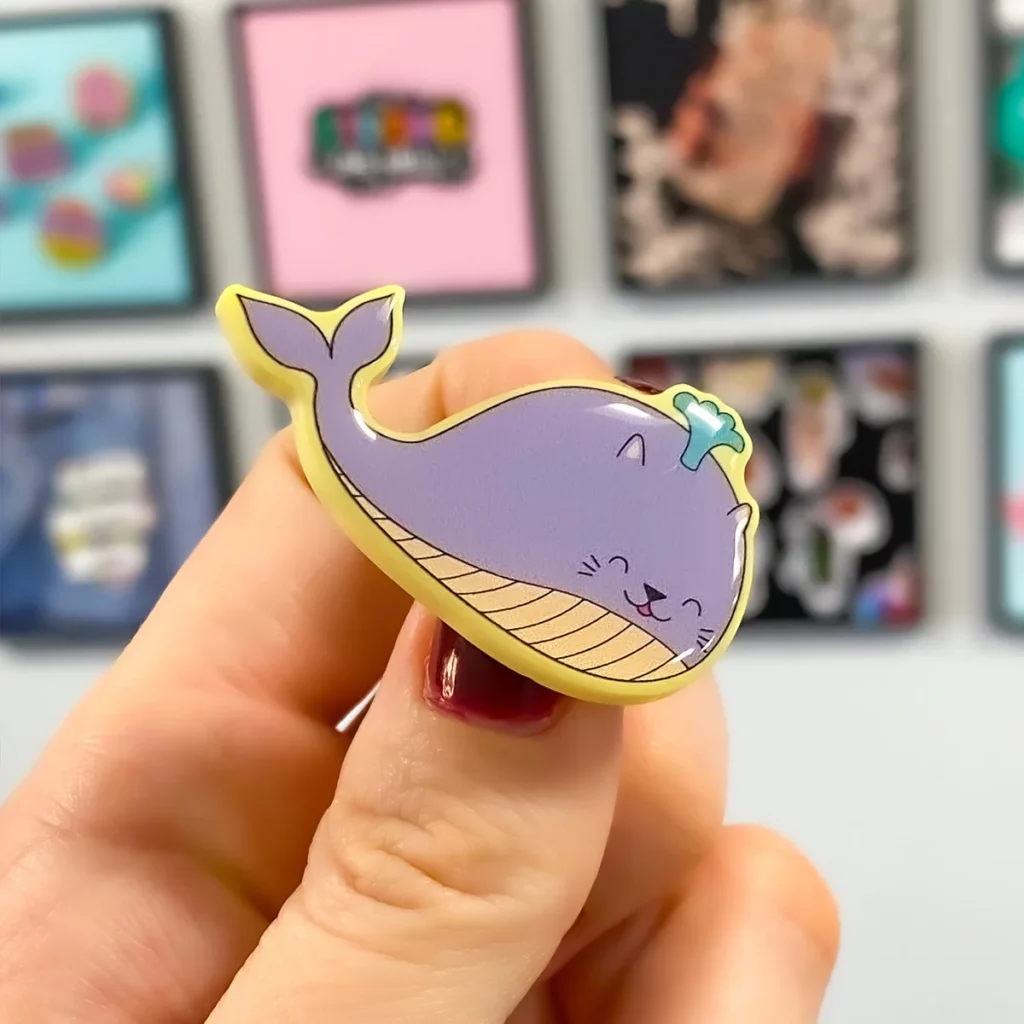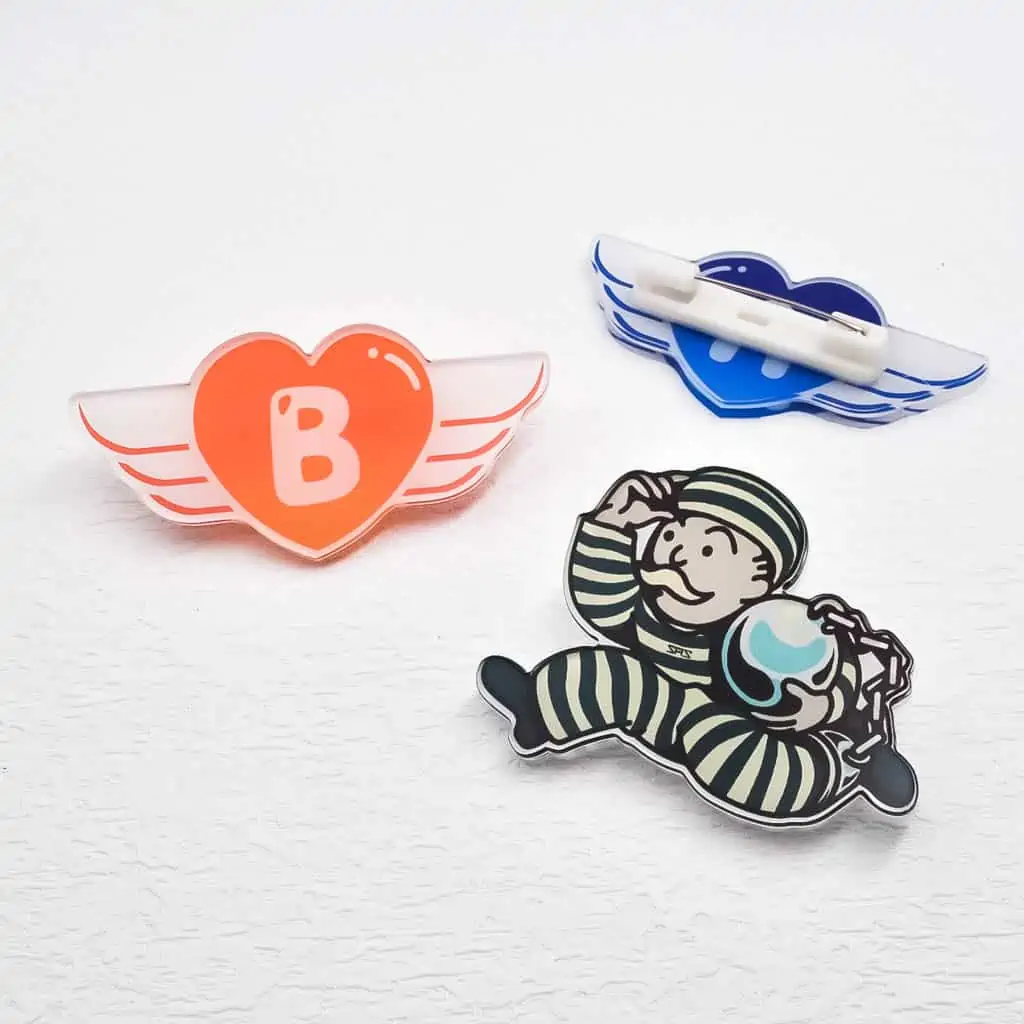Why Acrylic Pins Are Trending in Global Promotional Products
Why Are Acrylic Pins Gaining Popularity in the Global Promotional Products Market?
Acrylic pins are experiencing unprecedented growth as businesses seek distinctive promotional items that capture attention in an increasingly crowded marketplace. These versatile accessories offer brands the ability to create full-colour designs on clear acrylic material, enabling customised shapes and vibrant graphics that traditional metal pins simply cannot match.
The surge in Acrylic Pins popularity coincides with remarkable expansion across the entire promotional products sector. The global promotional pins market is projected to reach £3.0 billion by 2027, growing at a compound annual growth rate of 5.2% from 2023. This growth trajectory reflects businesses’ renewed investment in tangible marketing materials as in-person events return to pre-pandemic levels.
Modern branding strategies demand promotional items that stand out from conventional offerings. Acrylic pins deliver this differentiation through:
- Unlimited colour possibilities without the constraints of traditional enamel processes
- Unique transparency effects that create depth and visual interest
- Cost-effective production for complex designs that would be expensive in metal
- Lightweight construction ideal for everyday wear
The shift towards acrylic pins represents a broader trend where brands prioritise visual impact and memorability over traditional materials. As companies compete for consumer attention across digital and physical touchpoints, these eye-catching promotional products provide a tangible connection that resonates with modern audiences seeking authentic brand experiences.
What Is Driving the Growth of the Global Promotional Pins Market?
The promotional pins market growth is experiencing unprecedented momentum, with projections indicating the industry will reach $3.8 billion by 2027, expanding at a robust 5.2% compound annual growth rate from 2023. This substantial expansion reflects the increasing recognition of promotional products as essential marketing tools.
Corporate branding budgets have become a primary catalyst behind this surge. Companies are allocating larger portions of their marketing spend to tangible promotional items that create lasting brand impressions. Acrylic pins, with their vibrant full-colour printing capabilities and customisable shapes, offer exceptional value within these expanded budgets whilst delivering maximum visual impact.
The in-person events resurgence following the pandemic has dramatically amplified demand for promotional items. Trade shows, conferences, corporate gatherings, and networking events have returned with renewed enthusiasm, creating massive opportunities for brands to distribute memorable promotional products.
Key growth drivers include:
- Event marketing revival: Companies are compensating for lost face-to-face interactions with enhanced promotional strategies
- Brand differentiation needs: Businesses require unique items that stand out in crowded marketplaces
- Employee engagement programmes: Internal branding initiatives are driving demand for custom promotional items
- Customer loyalty initiatives: Brands are investing in tangible rewards that strengthen customer relationships
The convergence of increased marketing budgets, technological advances in production, and the return of physical events creates an ideal environment for promotional pins market expansion.
How Do Technological Advances Influence Acrylic Pin Production?
Advanced personalisation technology has transformed acrylic pin manufacturing, making it possible to create intricate designs with lifelike details at competitive prices. Today’s production facilities can handle complex artwork that would have been prohibitively expensive just five years ago.
AI-assisted design tools make the creative process more efficient by automatically optimising artwork for acrylic pin production. These systems examine design elements and propose changes that improve visual impact while keeping production feasible. The technology identifies potential manufacturing problems before production starts, saving expensive revisions.
Automated colour matching systems guarantee consistent colour reproduction across large orders. These advanced tools:
- Calibrate printing equipment to precise colour specifications
- Minimise human error in colour selection processes
- Uphold quality standards across multiple production runs
- Enable accurate Pantone colour matching for brand consistency
The combination of these technological advances has reduced production lead times by 30-45% across the acrylic pin industry. Manufacturers can now handle custom orders more efficiently, making small-batch productions financially viable for businesses with limited budgets.
Digital workflow integration links design approval systems directly to production equipment, removing manual handoffs that previously caused delays. This smooth process allows brands to move from concept approval to finished products in record time, meeting tight campaign deadlines that define modern marketing initiatives.
What Sustainability Trends Affect Acrylic Pins in Promotional Products?
The promotional products industry faces unprecedented pressure to adopt sustainable materials as 68% of B2B buyers now prioritise eco-friendly merchandise in their purchasing decisions. This dramatic shift has transformed how companies evaluate promotional items, with environmental impact becoming a primary selection criterion alongside cost and design appeal.
Acrylic pins occupy a unique position within this sustainability landscape. Unlike traditional metal alternatives that require energy-intensive mining and smelting processes, acrylic materials can be sourced from recycled plastics and manufactured with lower carbon emissions. The production process generates minimal waste, as excess acrylic material can be recycled back into new products.
Key sustainability advantages of acrylic pins include:
- Recyclable base materials reducing landfill impact
- Lower energy consumption during manufacturing compared to metal processing
- Reduced shipping emissions due to lighter weight
- Elimination of toxic plating chemicals used in metal pin production
The shift towards eco-friendly merchandise has positioned acrylic pins as an attractive alternative for environmentally conscious brands. Companies seeking to demonstrate their sustainability commitments find acrylic pins align with their corporate social responsibility goals whilst maintaining visual impact and cost-effectiveness.
Modern acrylic formulations incorporate bio-based additives and recycled content, addressing previous concerns about plastic-based promotional products. This evolution explains Why Acrylic Pins Are Trending in Global Promotional Products – they satisfy both environmental requirements and marketing objectives without compromising on quality or aesthetic appeal.
Which Industries Are Leading Demand for Acrylic Promotional Pins?
Educational institutions promotional products represent one of the fastest-growing segments for acrylic pins. Universities and schools choose these versatile promotional items for alumni events, graduation ceremonies, and student recruitment campaigns due to their ability to showcase detailed logos and mascots in vibrant colours.
Academic institutions particularly value acrylic pins for their cost-effectiveness when ordering in bulk quantities. Student organisations use them for club membership identification, whilst administrative departments distribute them during orientation weeks and campus tours. The clear material allows for intricate design elements that traditional metal pins cannot achieve, making them ideal for representing complex university crests or department logos.

Political campaign pins have experienced a remarkable surge in acrylic adoption during recent election cycles. Campaign managers favour these pins because they can display candidate photographs, detailed policy graphics, and multi-coloured party branding with exceptional clarity.
The lightweight nature of acrylic pins makes them perfect for mass distribution at rallies, town halls, and door-to-door canvassing. Political organisations appreciate the quick turnaround times enabled by modern production technologies, allowing them to create event-specific designs or respond rapidly to campaign developments. The material’s durability ensures pins remain intact throughout extended campaign periods, whilst the visual impact helps create memorable voter connections that traditional button badges often fail to achieve.
How Do Regional Production and Consumption Affect Acrylic Pin Trends?
The Asia-Pacific production share dominates the global promotional pins landscape, controlling 72% of manufacturing operations. This concentration creates significant influence over design trends, with Asian manufacturers driving innovation in acrylic pin production techniques and aesthetic preferences that ripple across international markets.
Manufacturing Hubs and Their Advantages
Manufacturing hubs in China, Taiwan, and South Korea have established sophisticated supply chains specifically optimised for acrylic pin production. These facilities leverage:
- Advanced printing technologies for vibrant colour reproduction
- Streamlined production processes reducing costs by 25-40%
- Rapid prototyping capabilities enabling faster design iterations
- Access to specialised acrylic materials and finishing techniques
The Impact of North America on Global Acrylic Pin Trends
North America consumption demand represents 41% of global market share, creating a powerful dynamic between Asian production capabilities and Western consumer preferences. This geographical split influences several critical factors:
- The distance between production centres and primary markets affects lead times, typically extending delivery schedules by 2-3 weeks for custom acrylic pin orders.
- Established distribution networks have adapted to meet North American demand patterns, with many suppliers maintaining inventory hubs in major US cities.
- Design preferences reflect this East-West dynamic, with Asian manufacturers incorporating Western aesthetic sensibilities whilst introducing innovative production techniques.
The result is acrylic pins that blend traditional promotional product functionality with contemporary design elements appealing to diverse global audiences.
What Cost Factors Should Be Considered When Choosing Acrylic Pins?
Mold creation fees represent the primary upfront investment when ordering acrylic pins. These one-time charges typically range from £50-£200 per design, depending on complexity and size requirements. The mold serves as the foundation for all subsequent production runs, making it a crucial cost consideration for budget planning.
Setup charges encompass additional production preparation costs beyond mold creation. These fees cover design file processing, colour calibration, and quality control testing. Most manufacturers apply setup charges of £25-£75 per order, regardless of quantity, making larger orders more cost-effective per unit.
Key Cost Components
- Material costs: Acrylic sheets and backing materials
- Printing expenses: Full-colour digital printing processes
- Cutting fees: Precision laser or die-cutting services
- Assembly charges: Attaching pins, clasps, or backing cards
- Packaging costs: Individual bagging or custom presentation options
Quantity breaks significantly impact per-unit pricing. Orders of 100 units might cost £2.50 each, whilst 1,000 units could reduce costs to £1.20 per pin. This pricing structure explains why acrylic pins are trending in global promotional products – brands can achieve professional results without the substantial minimum orders required for traditional metal pins.
Rush order premiums of 25-50% apply when standard 10-14 day production timelines cannot be met, making advance planning essential for budget-conscious campaigns.
Are There Any Drawbacks to Using Acrylic Pins as Promotional Products?
The disadvantages of using acrylic pins revolve around concerns about perceived value and durability that brands must consider in relation to their promotional goals. These limitations can affect the effectiveness of a campaign depending on the expectations of the target audience and the intended use of the products.
Challenges with Perceived Value
Acrylic materials are often associated with cheaper consumer goods, which can undermine the premium feel that many brands desire in their promotional merchandise. Recipients may view acrylic pins as less valuable compared to traditional metal options, potentially impacting brand positioning strategies. This perception becomes especially problematic when targeting corporate executives or high-value clients who anticipate receiving substantial promotional gifts.
Limitations in Durability
Temperature sensitivity presents significant challenges for acrylic pins in certain environments. Extreme heat can cause warping or discolouration, while cold temperatures may increase brittleness and lead to cracks. These conditions make them less suitable for outdoor events or industries operating in harsh environments.
Susceptibility to scratches is another concern, as acrylic surfaces show wear more easily than hard enamel alternatives. Frequent handling or contact with rough surfaces can result in visible damage that diminishes the pin’s appearance over time.
Constraints in Design
While acrylic allows for vibrant full-colour printing, it cannot replicate the three-dimensional textures and premium finishes that metal pins offer. The flat surface profile may appear less sophisticated for brands seeking a more elevated aesthetic appeal in their promotional materials. However, employing advanced techniques such as soft-touch coating can enhance the tactile quality of acrylic pins, making them more appealing despite their inherent limitations.

Conclusion
The world of promotional products is constantly changing, and acrylic pins are becoming a popular choice for brands that want to stand out. These versatile items not only look great but also have production benefits that fit with today’s marketing needs.
Here are the reasons why acrylic pins are becoming increasingly popular in the global promotional products industry:
- Full-colour printing capabilities that create stunning visual effects
- Competitive pricing structures suitable for various budget ranges
- Reduced production lead times through advanced manufacturing technologies
- Customisable shapes that break away from traditional pin limitations
The growth of the $3.8 billion promotional pins market at a rate of 5.2% per year shows that there is a demand for unique and cost-effective options. Brands looking to differentiate themselves find acrylic pins particularly appealing because they can showcase intricate designs while keeping costs down.
Smart brands understand that successful promotional strategies need a mix of traditional methods and innovative ideas. Acrylic pins provide this balance perfectly—offering the memorability of custom merchandise while also incorporating technological advancements and sustainability considerations that resonate with modern consumers.
See Also: Why Custom Coins Are a Unique Choice for International Corporate Gifts.
FAQs on Acrylic Pins in the Promotional Products Market
Acrylic pins offer full-colour printing, customisable shapes, transparency effects, and lightweight construction, which traditional metal pins cannot achieve. They also allow for intricate designs at lower production costs.
Popularity is driven by brand differentiation needs, event marketing resurgence, cost-effective production, and sustainability trends, along with the return of in-person events post-pandemic.
AI-assisted design tools, automated colour matching, and digital workflow integration allow faster production, precise colour accuracy, and small-batch manufacturing, reducing lead times by 30-45%.
Yes. Many acrylic pins are made from recycled plastics and bio-based materials, consume less energy in manufacturing, and generate minimal waste compared to metal alternatives, aligning with sustainability goals.
Key industries include:
Educational institutions for student events and alumni merchandise
Political campaigns for rallies and promotional materials
Corporate brands for employee engagement and customer loyalty programs
The Asia-Pacific region dominates production, leveraging advanced printing and prototyping. North American consumption drives design trends, creating a blend of innovative production and global aesthetic appeal.

